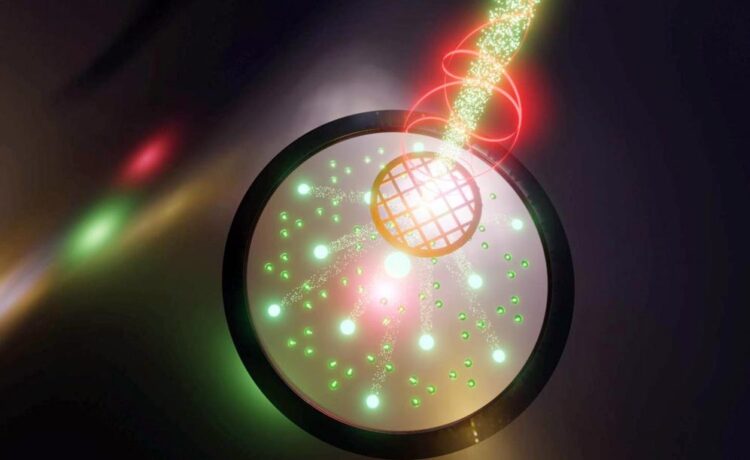Crystal structures in super slow motion

At the heart of the imaging technique is a complex array of 72 circular apertures
Credit: Dr Murat Sivis
Physicists from Göttingen first to succeed in filming a phase transition with extremely high spatial and temporal resolution.
Laser beams can be used to change the properties of materials in an extremely precise way. This principle is already widely used in technologies such as rewritable DVDs. However, the underlying processes generally take place at such unimaginably fast speeds and at such a small scale that they have so far eluded direct observation. Researchers at the University of Göttingen and the Max Planck Institute (MPI) for Biophysical Chemistry in Göttingen have now managed to film, for the first time, the laser transformation of a crystal structure with nanometre resolution and in slow motion in an electron microscope. The results have been published in the journal Science.
The team, which includes Thomas Danz and Professor Claus Ropers, took advantage of an unusual property of a material made up of atomically thin layers of sulphur and tantalum atoms. At room temperature, its crystal structure is distorted into tiny wavelike structures – a “charge-density wave” is formed. At higher temperatures, a phase transition occurs in which the original microscopic waves suddenly disappear. The electrical conductivity also changes drastically, an interesting effect for nano-electronics.
In their experiments, the researchers induced this phase transition with short laser pulses and recorded a film of the charge-density wave reaction. “What we observe is the rapid formation and growth of tiny regions where the material was switched to the next phase,” explains first author Thomas Danz from Göttingen University. “The Ultrafast Transmission Electron Microscope developed in Göttingen offers the highest time resolution for such imaging in the world today.” The special feature of the experiment lies in a newly developed imaging technique, which is particularly sensitive to the specific changes observed in this phase transition. The Göttingen physicists use it to take images that are composed exclusively of electrons that have been scattered by the crystal’s waviness.
Their cutting-edge approach allows the researchers to gain fundamental insights into light-induced structural changes. “We are already in a position to transfer our imaging technique to other crystal structures,” says Professor Claus Ropers, leader of Nano-Optics and Ultrafast Dynamics at Göttingen University and Director at the MPI for Biophysical Chemistry. “In this way, we not only answer fundamental questions in solid-state physics, but also open up new perspectives for optically switchable materials in future, intelligent nano-electronics.”
###
Original publication: Thomas Danz et al., Ultrafast nanoimaging of the order parameter in a structural phase transition, Science 2021, doi:10.1126/science.abd2774
Contact:
Thomas Danz
University of Göttingen
Faculty of Physics
Nano-Optics and Ultrafast Dynamics
Friedrich-Hund-Platz 1, 37077 Göttingen, Germany
Email: thomas.danz@uni-goettingen.de
Professor Claus Ropers
University of Göttingen
Faculty of Physics
Nano-Optics and Ultrafast Dynamics
and Max Planck Institute for Biophysical Chemistry – Ultrafast Dynamics
Friedrich-Hund-Platz 1, 37077 Göttingen, Germany
Tel: +49 (0) 551 39-24549
Email: claus.ropers@uni-goettingen.de
http://www.
All latest news from the category: Physics and Astronomy
This area deals with the fundamental laws and building blocks of nature and how they interact, the properties and the behavior of matter, and research into space and time and their structures.
innovations-report provides in-depth reports and articles on subjects such as astrophysics, laser technologies, nuclear, quantum, particle and solid-state physics, nanotechnologies, planetary research and findings (Mars, Venus) and developments related to the Hubble Telescope.
Newest articles

Innovative 3D printed scaffolds offer new hope for bone healing
Researchers at the Institute for Bioengineering of Catalonia have developed novel 3D printed PLA-CaP scaffolds that promote blood vessel formation, ensuring better healing and regeneration of bone tissue. Bone is…

The surprising role of gut infection in Alzheimer’s disease
ASU- and Banner Alzheimer’s Institute-led study implicates link between a common virus and the disease, which travels from the gut to the brain and may be a target for antiviral…

Molecular gardening: New enzymes discovered for protein modification pruning
How deubiquitinases USP53 and USP54 cleave long polyubiquitin chains and how the former is linked to liver disease in children. Deubiquitinases (DUBs) are enzymes used by cells to trim protein…


